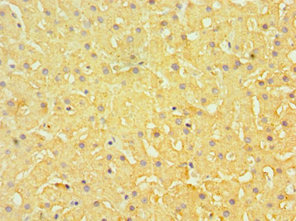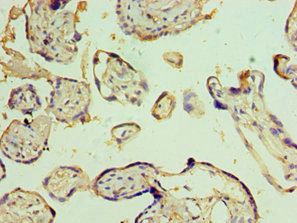EFNB1 Antibody
-
货号:CSB-PA007465ESR1HU
-
规格:¥440
-
促销:
-
图片:
-
其他:
产品详情
-
产品名称:Rabbit anti-Homo sapiens (Human) EFNB1 Polyclonal antibody
-
Uniprot No.:P98172
-
基因名:EFNB1
-
别名:EFNB1; EFL3; EPLG2; LERK2; Ephrin-B1; EFL-3; ELK ligand; ELK-L; EPH-related receptor tyrosine kinase ligand 2; LERK-2
-
宿主:Rabbit
-
反应种属:Human
-
免疫原:Recombinant Human Ephrin-B1 protein (28-237AA)
-
免疫原种属:Homo sapiens (Human)
-
标记方式:Non-conjugated
-
克隆类型:Polyclonal
-
抗体亚型:IgG
-
纯化方式:Antigen Affinity Purified
-
浓度:It differs from different batches. Please contact us to confirm it.
-
保存缓冲液:PBS with 0.02% sodium azide, 50% glycerol, pH7.3.
-
产品提供形式:Liquid
-
应用范围:ELISA, IHC
-
推荐稀释比:
Application Recommended Dilution IHC 1:20-1:200 -
Protocols:
-
储存条件:Upon receipt, store at -20°C or -80°C. Avoid repeated freeze.
-
货期:Basically, we can dispatch the products out in 1-3 working days after receiving your orders. Delivery time maybe differs from different purchasing way or location, please kindly consult your local distributors for specific delivery time.
相关产品
靶点详情
-
功能:Cell surface transmembrane ligand for Eph receptors, a family of receptor tyrosine kinases which are crucial for migration, repulsion and adhesion during neuronal, vascular and epithelial development. Binding to Eph receptors residing on adjacent cells leads to contact-dependent bidirectional signaling into neighboring cells. Shows high affinity for the receptor tyrosine kinase EPHB1/ELK. Can also bind EPHB2 and EPHB3. Binds to, and induces collapse of, commissural axons/growth cones in vitro. May play a role in constraining the orientation of longitudinally projecting axons.
-
基因功能参考文献:
- Lymphomas with low UTX expression express high levels of Efnb1, and cause significantly poor survival. PMID: 30006524
- Chronic hypoxia-induced slug promotes invasive behavior of prostate cancer cells by activating the expression of ephrin-B1. PMID: 30058095
- This study showed that EphB2 cells have a transient increase in migration after heterotypic activation, which underlies a shift in the EphB2-ephrinB1 border but is not required for segregation or border sharpening. PMID: 28747399
- that expression of EFNB1 and EFNB2 is implicated in Th cell differentiation and migration to inflammatory sites in both EAE and MS PMID: 27039370
- we demonstrate that mosaicism for EPHRIN-B1 expression induced by random X inactivation in heterozygous females results in robust cell segregation in human neuroepithelial cells, thus supplying experimental evidence that Eph/ephrin-mediated cell segregation is relevant to pathogenesis in human CFNS patients. PMID: 28238796
- one novel (IVS2+3G>T) and one previously reported mutation (p.Gly151Ser) in EFNB1 Both patients were de novo cases without a family history of Craniofrontonasal syndrome. PMID: 27650623
- While ephrin-B1 deficiency leads to abnormal visual pathways in mice, it leaves the human visual system, apart from deficits in binocular vision, largely normal. PMID: 26580852
- that EphrinB1 (EFNB1) co-localizes with microtubules (MTs) during all phases of the cell cycle. PMID: 25436983
- we report a family with a G151S mutation in the EFNB1 gene. The mutation was identified in two severely affected sisters and paradoxically in their clinically unaffected father. PMID: 25486017
- T cells from rheumatoid arthritis (RA) patients expressed higher EFNB1 mRNA levels, which correlated with RA symptoms and laboratory findings. Expression of EFNB1 in T cells might be a parameter for monitoring RA disease activity and treatment responses. PMID: 25779027
- Results indicate that EphrinB1 is uniquely dysregulated in medulloblastoma and promotes oncogenic responses in medulloblastoma cells, implicating ephrinB1 as a potential target PMID: 25258252
- EphB2/ephrin-B1 were invoked in dental pulp stem cells with TNF-alpha treatment via the JNK-dependent pathway, but not NF-kB, p38 MAPK or MEK signalling. PMID: 25643922
- Patients with EFNB1 mutations have a clear phenotype. This study will facilitate genetic counseling of parents and patients, and contribute to the diagnostic and screening process of patients with suspected CFNS. PMID: 24281372
- CNK1 mediates ephrinB1 signaling that promotes cell migration through RhoA and JNK activity. PMID: 24825906
- EphrinB1 expression is related to the metastasis of breast cancer and its enhanced expression confers a poor prognosis, suggesting that EphrinB1 may be a relevant therapeutic target in breast cancers. PMID: 24240587
- High EFNB1 expression is associated with squamous cell carcinomas of the head and neck. PMID: 23811940
- we report the identification of mosaic EFNB1 mutations in every individual with craniofrontonasal syndrome, confirming the suggested diagnosis and supporting the hypothesis of cellular interference in humans. PMID: 23335590
- These results indicate a novel function of Nm23-H1 to control contact inhibition of locomotion, and its negative regulation by ephrin-B1. PMID: 22718351
- Data show that EphrinB1, a PTPN13 substrate, interacts with ErbB2, and Src kinase mediates EphrinB1 phosphorylation and subsequent MAP Kinase signaling. PMID: 22279592
- X-linked cases resembling Teebi hypertelorism may have a similar mechanism to CFNS, and that cellular mosaicism for different levels of ephrin-B1 (as well as simple presence/absence) leads to craniofacial abnormalities. PMID: 21542058
- Unreported mutation in EFNB1 predicts occurrence of congenital diaphragmatic hernia, phenotypic differences between males and female. PMID: 20734337
- The impact of craniofrontonasal syndrome-causing EFNB1 mutations on ephrin-B1 function is reported. PMID: 20565770
- study reports that the expression of ephrin-B1 is controlled by a feedback loop involving posttranscriptional regulatory mechanisms PMID: 20308325
- combination of SDF-1, PTN, IGF2, and EFNB1 mimics the DA phenotype-inducing property of SDIA and was sufficient to promote differentiation of hESC to functional midbrain DA neurons PMID: 19672298
- Human platelets express EphA4 and EphB1, and the ligand, ephrinB1. Forced clustering of EphA4 or ephrinB1 led to cytoskeletal reorganization, adhesion to fibrinogen, and alpha-granule secretion. PMID: 12084815
- Expression profile of this ligand of EPHB2 in gastric cancer PMID: 12136247
- The expression of ephrin-B1 was correlated with a poorer clinical prognosis. Ephrin-B1 protein was expressed by osteosarcoma cells and blood vessels. PMID: 12209731
- Results identified a novel interaction between EphB1 with the adaptor molecule Grb7 and suggested that this interaction may play a role in the regulation of cell migration by EphB1. PMID: 12223469
- expression of Eph-B1 in plasmacytoid dendritic cells PMID: 12384430
- Ephrin B1 induces human aortic endothelial cells migration in a pathway that involves Crk adaptor protein PMID: 12475948
- conclude that ephrinB1 and B class Eph receptors provide positional cues required for the normal morphogenesis of skeletal elements PMID: 12919674
- Eph/ephrin signaling enhances the ability of platelet agonists to cause aggregation by activating Rap1 and these effects require oligomerization of ephrinB1 but not phosphotyrosine-based interactions with the ephrinB1 cytoplasmic domain. PMID: 14576067
- Ephrin-B1 may be involved in in vivo tumor progression by promoting neovascularization in hepatocellular carcinoma PMID: 14642617
- Mutations of the ephrin-B1 gene cause craniofrontonasal syndrome PMID: 15124102
- ephrin-B1 internalization is an active receptor-mediated process that utilizes the clathrin-mediated endocytic pathway PMID: 15351694
- On ephrinB1 stimulation, the small GTPases Rho and Ras are activated and Rap1 is inactivated. PMID: 15725075
- EFNB1 mutations have a role in familial and sporadic craniofrontonasal syndrome (CFNS) PMID: 15959873
- EphB/ephrin-B molecules play a role in restricting dental pulp stem cell attachment and migration to maintain Dthesse cells within their stem cell niche under steady-state conditions. PMID: 17204606
- C-terminus of ephrin-B1 regulates activation of the extracellular release of MMP-8 without requirement of de novo protein synthesis. PMID: 17567680
- Our results suggest that tyrosine phosphorylation of ephrin-B1 promotes invasion of cancer cells in vivo PMID: 17591954
- Silencing of EphB expression is associated with colorectal tumorigenesis. PMID: 17906625
- EphrinB1 may play an important role in the inflammatory states of rheumatoid arthritis, by affecting the population/function of T cells. PMID: 17942634
- EFNB1 mutant transcripts with nonsense codons are degraded by the nonsense-mediated mRNA decay pathway and lead to craniofrontonasal syndrome. PMID: 18043713
- Ephrin-B1 is likely to play an important role in the regulation of malignant T lymphocytes through the control of lipid-raft-associated signaling, adhesion, and invasive activity PMID: 18314490
- Several new EFNB1 mutations have been identified in craniofrontonasal syndrome. PMID: 18627045
显示更多
收起更多
-
相关疾病:Craniofrontonasal syndrome (CFNS)
-
亚细胞定位:Cell membrane; Single-pass type I membrane protein. Membrane raft.; [Ephrin-B1 C-terminal fragment]: Cell membrane; Single-pass type I membrane protein.; [Ephrin-B1 intracellular domain]: Nucleus.
-
蛋白家族:Ephrin family
-
组织特异性:Widely expressed. Detected in both neuronal and non-neuronal tissues. Seems to have particularly strong expression in retina, sciatic nerve, heart and spinal cord.
-
数据库链接:
HGNC: 3226
OMIM: 300035
KEGG: hsa:1947
STRING: 9606.ENSP00000204961
UniGene: Hs.144700
Most popular with customers
-
-
YWHAB Recombinant Monoclonal Antibody
Applications: ELISA, WB, IF, FC
Species Reactivity: Human, Mouse, Rat
-
Phospho-YAP1 (S127) Recombinant Monoclonal Antibody
Applications: ELISA, WB, IHC
Species Reactivity: Human
-
-
-
-
-























